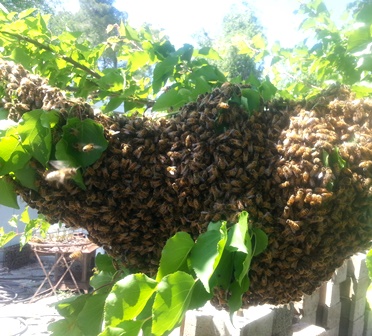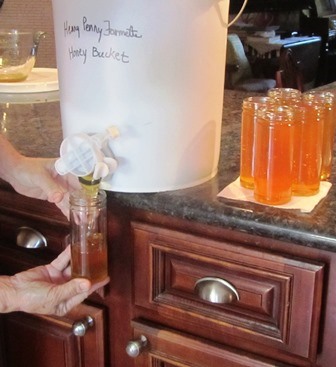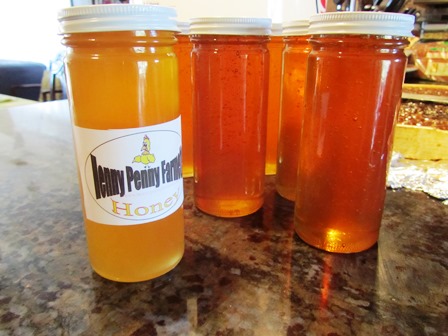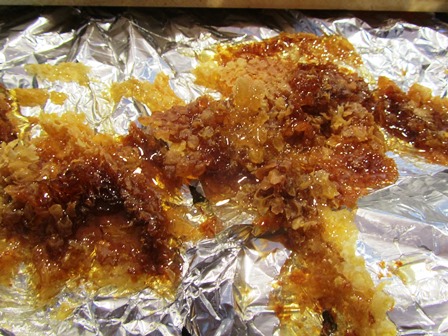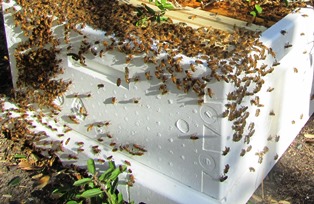Lemon Oil for Luring Honeybee Swarms
Call it my sixth sense at work, but after my bees acted aggressive (which they usually are not) as I cleaned the water fountain, I prepared the swarm catcher and put it in the apricot tree nearest my office window. Mid-morning on Wednesday, I got my first swarm of 2016.
Lemon oil is often the ingredient that lures the honeybees to a swarm catcher. I mix the lemon oil mixed with water and spray the swarm catcher with a pump sprayer. It usually works better to capture the bees in the swarm catcher than having them coalesce en masse on an inconvenient limb in a tree, say, fourteen feet up.
You can use lemon oil as a salve or in the oil form–apply the salve onto the swarm catcher around the opening for the bees or use the oil in a small plastic vial that gets inserted into a swarm catcher orifice.
Bear in mind that not all lemon oils are equal. Some are more “lemony scented” than others. Lemon oil is cold pressed from the peel and contains 3 to 10 percent citral (considered the most powerful of components that contribute to the lemon scent). Lemon myrtle contains 95 percent citral and, if it’s the scent you want, lemon myrtle is superior to all others.
So, when I realized my bees were swarming, I suited up and prepared a hive box with ten frames, eight with wax from previous honey harvests (where I left the wax intact) and two that I had in the kitchen where I was draining honey from them. It would provide an immediate source of food for the bees in their new home.
Today, I visited my favorite shop for all things honeybees and stocked up on a couple more hive boxes, just in case of another swarm, although the bees are quiet and non-aggressive again.
A Good Day to Strain, Drain, and Bottle Honey
It’s Sunday. I’m bottling the honey that I pulled from the hives last week. Yesterday, I washed two dozen eight-ounce jars in the dishwasher and allowed them to dry upside down on paper towels. Today, I’ll put on my apron and listen to some energetic big band tunes while I drain that honey into jars.
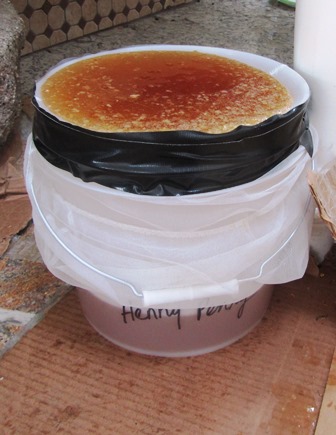
The fine mesh strainer taped tightly around the bucket rim traps the bits of wax but does not impede the flow of honey
My buckets of honey still have duct tape around their rims holding the strainers in position. When the honey was spun in the extracting machine, it had to be drained through a filter. Painter’s filters work great as the mesh cloth is very fine and fits over the top of the bucket.
The filter is placed into position around the rim and then duct taped is wrapped around tightly two times. Honey is quite heavy and can pull down the filter if not secured. I’m straining the honey that goes into jars. However, I did save back a jar of unfiltered honey with all those bits in it for a family member who prefers it that way.
The work was easier and went faster than I’d expected. It helps to have everything you need close at hand, clean, and ready to go.
Of the three large buckets, the first had a nice spigot than I could turn off after I allowed honey to flow and fill the jar. Then I closed the spigot, wiped the jar with a damp paper towel, and then screwed the lid in place.
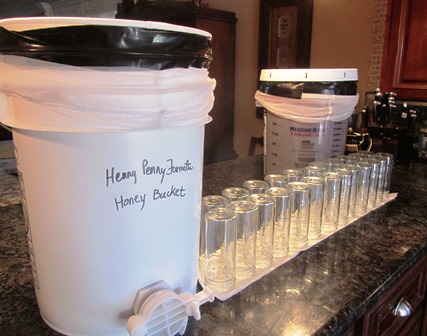
This five-gallon honey bucket will fill approximately five dozen eight-ounce jars; pictured here are 24 jars
The two dozen eight-ounce jars barely made a dent in my first honey bucket although my neighbor tells me that I can easily fill five dozen of the eight-ounce jars from one five-gallon bucket; or, I can fill two and one-half dozen of the sixteen-ounce jars.

Filled jars reveal clear, light amber honey the bees made from the French perfume lavender on my farmette and our springtime flowers, but these jars still labels
The next step in the process is to affix my Henny Penny label onto the jar. I plan to give some of these jars away during promotions in early October for my forthcoming novel, A BEELINE TO MURDER, the first in the Henny Penny Farmette series of cozies.

Published next month by Kensington, my book is available on Amazon, Barnes & Noble, and through most booksellers and online bookstores
If you are interested in this honey, please feel free to email me at meeralester1@gmail.com.
What to Do When Ants Invade the Honey Bucket
My five-gallon honey bucket with the spigot makes it easy for me to fill up a jar of honey for friends or family. For easy access, I keep it on a round table in the kitchen.
Yesterday morning, I went to refill our own empty jar and noticed ants on the exterior of the bucket. It has a lid on it, but not too tight-fitting, so I held my breath and pulled off the lid.
Removing the lid, I found the ants had infiltrated it and hundreds floated in the honey. Imagine my dismay.
I consulted with my beekeeper neighbor about what to do with the now-unusable honey. Much to my surprise, he said save it. He told me to put it in the freezer (the one specifically used to freeze frames and therefore kill any pests we can’t see on the wax before returning those frames to the hives). So the bucket with the ants went into the freezer I keep on the patio.
My neighbor says the ants will die. The bees can then eat that honey when there isn’t enough pollen around, for example, during the winter. It’s a win-win . . . except for the ants.
Uncapping, Draining, and Straining a Frame of Honey
I have frames of honey wrapped in foil in my kitchen freezer. These frames haven’t yet been uncapped, drained, and strained for bottling.
Since the weather on the farmette has turned springlike, I can’t put this chore off any longer. Those frames have to come out of the freezer. They’re from late October. I’d wrapped them in aluminum foil and froze them until I could find time to work with them.
Once a frame had defrosted, I needed to open the cells of wax, capped by the bees. Opening capped cells becomes easier if you use a hot knife. I run mine through a gas burner and wipe frequently. After the cells are opened on both sides of the frame, I stand the rectangular wooden frame in a freshly washed two- or five-gallon bucket and cover the bucket with plastic wrap until the honey drains out.
Then, of course, the honey collected needs to be filtered. I use a bucket over which I’ve secured a thin painter’s net for straining paint. As the honey drains through, I twist around a large wooden spoon to tighten. Eventually, all that is left in the net strainer are pieces of wax. Many backyard beekeepers run honey through the straining process twice before bottling.
Using a coat hanger, I hang the frames (from which I harvested the honey) in a tree near the apiary. The bees will do the work of removing all traces of honey, leaving only wax. At this point, I’ll freeze the frames before reusing them.
This is a very old fashion way of harvesting honey. There are modern appliances and other tools, including an electric hot knife and honey extractor machines, that serious beekeepers can use. But the old ways, although more laborious, still work.
Honeybee Hive Pests Include Real Vampires
Every beekeeper wants to keep his or her hives healthy. Staying on top of your bee’s health means early detection and treatment of pests in the hive such as Varroa mites, trachea mites, hive beetles, and wax moths.
Varroa mites–these small reddish brown pests are akin to tiny vampires, feasting on your bees’ blood. Non-medicinal approaches to treating for these mites include introducing a screened bottom board. Mites fall through and cannot re-enter the hive to reattach to the bees. Also a powdered sugar dusting of your hives’ top bars can dislodge mites.
Tracheal mites–these pests are more difficult to detect. My beekeeper neighbor showed me infant baby bees with partial wings and said he believed it was the work of tracheal mites. To rid your hives of these pests, you’ll need to use menthol crystals and grease patties.
Hive beetles–if you see an insect with a hard, small black shell in corners and dark places within the hive, you may have hive beetles. They devour bee brood, honey, wax, and pollen. Treat the soil in front of the hive and inside the hive, you can try hive beetle traps or treat chemically. The infected honey will be rejected by the bees and should be considered unfit for human consumption as well.
Wax moths–these nasty little creatures can been seen in honeycomb and leave a silky trail over your hive’s hanging frames. If you see evidence that they’ve tunnel into the wood, know that you’ve had the infestation for a while. Wax moths will weaken a colony. Treat the infected hives with moth crystals formulated to eliminate wax moths in the hive.
Hives that are frequently checked their beekeepers stand the best chance for having healthy colonies of bees.
 Facebook
Facebook Goodreads
Goodreads LinkedIn
LinkedIn Meera Lester
Meera Lester Twitter
Twitter





